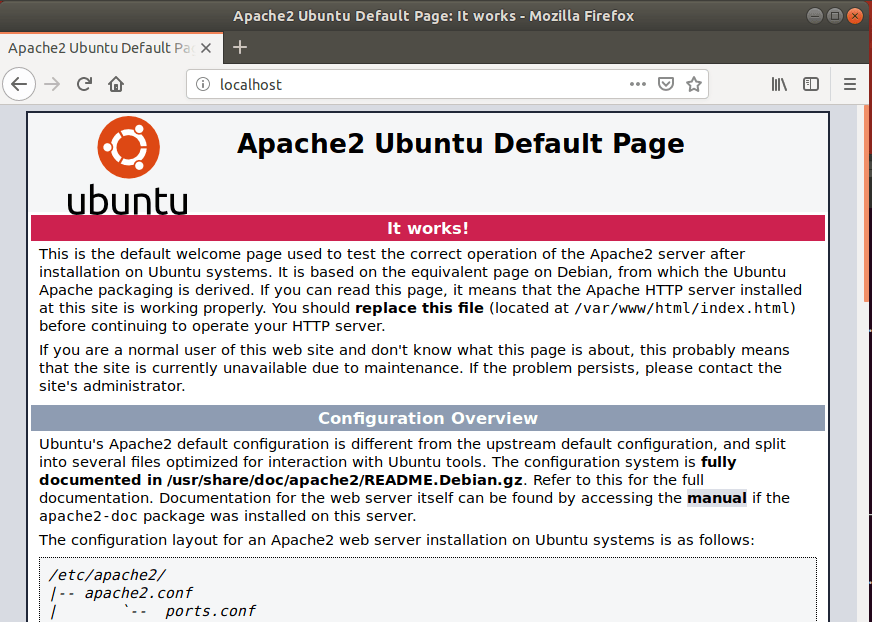For the uninitiated, JOJO is a free content management system (CMS) based on PHP that is easy to install and set up. Web developers anyone who wants to build beautiful websites can use Jojo CMS to do it! With JOJO CMS, you can run unlimited websites from a single set of core files, smart handling of CSS and JavaScript, and it’s search engine friendly. It comes with support for any templates, inline editing, drop ‘n drop, any language with an intuitive backend, and more. For more about JOJO, please check their Homepage To get started with installing JOJO CMS, follow the steps below:
Install Apache2 HTTP Server
JOJO CMS requires a web server and the Apache2 HTTP server is the most popular open-source web server available today. To install the Apache2 server, run the commands below: After installing Apache2, the commands below can be used to stop, start and enable the Apache2 service to always start up with the server boots. Now that Apache2 is installed. to test whether the web server is working, open your browser and browse to the URL below. If you see the page above, then Apache2 is successfully installed.
Install MariaDB Database Server
JOJO CMS also requires a database server to store its content. If you’re looking for a truly open-source database server, then MariaDB is a great place to start. To install MariaDB run the commands below: After installing MariaDB, the commands below can be used to stop, start and enable the MariaDB service always to start up when the server boots. Run these on Ubuntu 16.04 LTS Run these on Ubuntu 18.10 and 18.04 LTS Next, run the commands below to secure the database server with a root password if you were not prompted to do so during the installation. When prompted, answer the questions below by following the guide.
Enter current password for root (enter for none): Just press the Enter Set root password? [Y/n]: Y New password: Enter password Re-enter new password: Repeat password Remove anonymous users? [Y/n]: Y Disallow root login remotely? [Y/n]: Y Remove test database and access to it? [Y/n]: Y Reload privilege tables now? [Y/n]: Y
Now that MariaDB is installed, to test whether the database server was successfully installed, run the commands below. type the root password when prompted. If you see a similar screen as shown above, then the server was successfully installed.
Install PHP 7.2 and Related Modules
JOJO CMS is a PHP-based CMS and PHP is required. However, PHP 7.2 may not be available in Ubuntu’s default repositories. To run PHP 7.2 on Ubuntu 16.04 and previous, you may need to run the commands below: Then update and upgrade to PHP 7.2 Next, run the commands below to install PHP 7.2 and related modules. After installing PHP 7.2, run the commands below to open the PHP default configuration file for Apache2. The lines below are a good setting for most PHP-based CMS. Update the configuration file with these and save. Every time you make changes to the PHP configuration file, you should also restart the Apache2 web server. To do so, run the commands below: Now that PHP is installed, to test whether it’s functioning, create a test file called phpinfo.php in the Apache2 default root directory. ( /var/www/html/) Then type the content below and save the file. Next, open your browser and browse to the server’s hostname or IP address followed by phpinfo.php You should see the PHP default test page.
Create JOJO Database
Now that you’ve installed all the packages that are required for JOJO CMS to function, continue below to start configuring the servers. First, run the commands below to create a blank JOJO CMS database. To log on to the MariaDB database server, run the commands below. Then create a database called jojocms Create a database user called jojocmsuser with a new password Then grant the user full access to the database. Finally, save your changes and exit.
Download JOJO CMS Latest Release
After installing the server and packages above, go to the JOJO CMS download page and get the latest. Or use the commands below to download and clone the latest version of GitHub. You will also need to create a folder for your site content. This folder can be named anything you like – we will refer to the folder as ‘my site‘. This folder will contain 4 subfolders that are specific to each Jojo site. Downloads, for holding site-specific file uploads; cache, for site-specific cache files; plugins, for site-specific plugins; and themes, for site-specific themes. To create the folder, run the commands below: Next, run the commands below to set the correct permissions for the JOJO CMS root directory and give Apache2 control.
Configure Apache2
Finally, configure the Apahce2 site configuration file for JOJO CMS. This file will control how users access JOJO CMS content. Run the commands below to create a new configuration file called jojocms. conf Then copy and paste the content below into the file and save it. Replace the highlighted line with your domain name and directory root location. Save the file and exit.
Enable the JOJO CMS and Rewrite Module
After configuring the VirtualHost above, enable it by running the commands below Then open your browser and browse to the server domain name. You should see the JOJO CMS setup wizard complete. Please follow the wizard carefully. When you browse the domain, you may get prompted to update your .htaccess file. Copy and paste the code into the file below. Then copy and paste the content below into the file and save it. Then reload the page and begin the installation wizard Next, create the admin account and a master password and continue After that, type in the database information created above and continue. After a few minutes, JOJO CMS should be installed and ready to use. You will then start building your site. Enjoy~ Congratulation! You have successfully installed JOJO CMS on Ubuntu 16.04 | 18.04.



